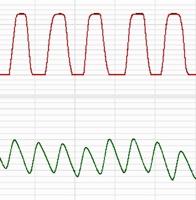In many acute and chronic pain conditions, pain has a throbbing quality that has long been attributed to the activation of sensory neurons by blood flow pulsations. Now, Andrew Ahn and colleagues at the University of Florida, Gainesville, US, challenge that view: In research published in the May 30 Journal of Neuroscience, they report that the throbbing rate is slower than the arterial pulse rate in patients with acute dental pain, and that the two rhythms show no synchrony. Understanding the mechanism of throbbing could provide important insight into treating one of pain’s most disabling characteristics.
Co-first authors Afia Mirza and Jue Mo and their colleagues measured arterial pulse and self-reported throbbing rates in 29 patients with acute dental pain and found that, as observed in Ahn’s earlier study of migraine patients (Ahn, 2010), the average throbbing rate was slower than the average pulse rate—44 beats per minute (bpm) for throbbing, compared with 73 bpm for pulse. In addition, the rates were independent, such that those patients with higher pulse rates, for example, did not have higher throbbing rates. Still, it was possible that pulse might drive throbbing indirectly—pain might throb with every other heartbeat, for instance. However, no synchrony was evident. Fluctuations in throbbing rate did not follow variations in pulse rate, either.
The results suggest that throbbing pain has little to do with pulse rate, and beg the question: What does set the pace? Ahn expects that throbbing is not a primary sensation, but rather a perception that arises somewhere in the brain. “If it’s not a sensation, then maybe it’s a perception,” he said. “And if it is a perception, what are the neurophysiologic mechanisms that drive it?”
Meanwhile, an important question is whether the temporal properties of throbbing migraine and dental pain are similar in other pain conditions. If so, that could suggest that throbbing has a common neurophysiologic basis, which could simplify future treatment efforts.
Image: In a patient with throbbing dental pain, the throbbing rate (top) is slower than the arterial pulse rate (bottom). Credit: A. Ahn.


